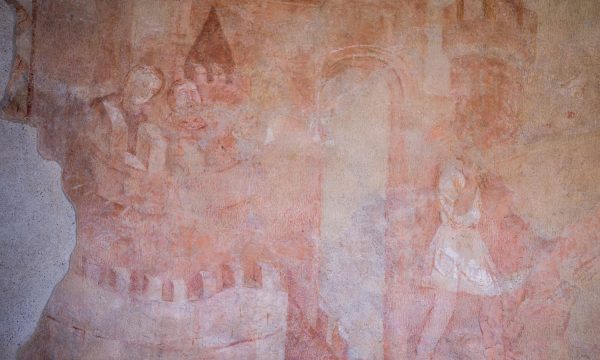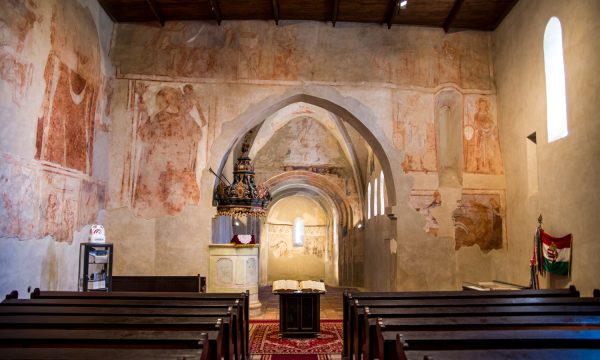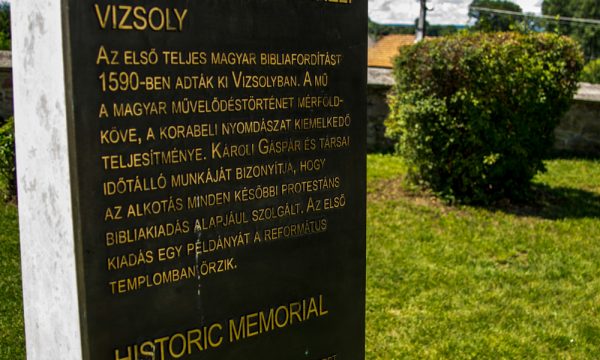Wall painting
According to the figures of the papal tithe register, the church dedicated to St. Andrew was among the most significant ones. The church, which was extended to the west several times, was already painted in early times and even fragments of its painted façade were known from this early period. The first church was probably built in the first third of the 13th century, which was extended to the west in the first half of the 14th century. Its tower was erected in the Middle Ages as well. The congregation converted to the Reformed faith in the middle of the 16th century. The printing of the first complete Hungarian translation of the Bible by Gáspár Károlyi was finished close to the church on July 20, 1590. From 1785 onwards, it had been renovated for several years, the painted wooden ceiling of the nave and the pulpit crown (sounding board) were completed in 1791–92, but only the latter exists today. There was a gallery in its choir as well, which was demolished during the first monumental restoration carried out according to Ottó Sztehlo’s plans. Its murals were found only in 1940 and their exploration was started by Gyula Szentiványi. However, the frescoes were uncovered and restored on a larger scale only in 1951-52. These works were carried out by Gyula Szentiványi and László Bartha. Their thorough and professional restoration was carried out by a team led by László Seres in 1984–85.

Its paintings are so complicated and span over so many periods that it should be discussed in a separate study, we can only enumerate them here. Research has revealed that the frescoes in the early apse and in the crossing date back to around 1250. Maiestas Domini (Christ in Glory) was depicted on the choir vault, of which only a small fraction has survived, just like the seraphim that were once observed there. On the side walls, in the cycle composed of several paintings in geometric frames only the Nativity story was depicted by the medieval master. Beside the nativity scene, the journey and adoration of the magi, possibly their departure from Jerusalem, several saints that are difficult to identify and fragments of various figures in quatrefoil frames can be observed, but the latter images are unidentifiable as they are local and very faded.
The church was newly painted after the extension and the vaulting of the former nave that was converted into a choir. Above the triumphal arch the Ascension of Christ can be recognized from the fragments that appear mostly as sinopie today. The mandorla is held up by two angels. Remnants of the celestial sphere can be presumably identified in the fragments of the caps, including the Intercession, the Holy Trinity, and angels. The Vir dolorum (Man of Sorrows) and figures kneeling beside him, donors and saints can be interpreted from the larger compositions of its side walls.

Large continuous surfaces can be studied on its Gothic triumphal arch and on the northern wall of its nave, but these are also heavily damaged and faded. They can be dated back to the first half of the 14th century and the first quarter of the 15th century as the works of masters working at different levels and in different periods of time. Unfortunately, in many cases, these paintings appear now only as sinopie because of their early unprofessional exploration and restoration.
The Nativity story was depicted in the upper register of its triumphal arch. Its scenes can be interpreted as the Angel’s Greeting, Mary and Elizabeth meeting, the Adoration of the Magi in the middle, barely recognizable today, and the Presentation of Jesus at the Temple. Below this sequence of paintings, the huge figure of St. Christopher on the northern side and two soldier saints and St. George fighting the dragon on the southern side of the triumphal arch are relatively better preserved. Here, beside the red some other colours can be observed as well. Similarly to the triumphal arch, a cycle composed of several scenes was painted in the uppermost part of its northern wall. The Legend of St. Ladislaus also appears as a sinopia. In the first scene, the army of the holy king leaves a huge castle. Several figures appear on the building and in front of its gate, but the army leaving the castle is barely perceptible, just like in the battle scene. The figure of St. Ladislaus can be interpreted here with his spear stretched out, in pursuit of the Cuman. The figures of the Cumans depicted in the same posture, shooting their arrows backwards and their schematically painted horses can also be identified. These two scenes merge, they are not separated by a frame. The following important scenes, the wrestling and the beheading are covered by a large painting from a later period. However, a part of the Resting scene can still be seen in the narrow section before the northeastern corner of the nave. Only the lying figure of King Ladislaus remained relatively intact, the figure of the girl was destroyed.
The huge painting covering the legend of St. Ladislaus can be identified as the Bosom of Abraham. Under this there are three separate framed paintings. The very faded figure of a female saint holding a sword in the east represents Saint Helena, the figure in the centre is Emperor Constantine the Great lifting up the Holy Cross, and the third frontal figure holding a lance was identified during the research as St. Michael. Located west of these paintings, a larger Crucifixion composition with many figures can be recognized from the separately framed murals that were painted in different periods, followed by the figure of Virgin Mary wearing a cloak. Angels hold a crown over her head, but these are so faded that they can hardly be recognized. West of this, we think that the figure of a saint holding a book can be seen and then an almost unidentifiable scene follows. Finally, a fragment suggesting the depiction of the Noli me tangere scene in a frame with cloud motifs closes the line of still identifiable frescoes, as we cannot undertake to identify the painting under the western gallery.
Natural heritage
This village is located in Szerencsköz, near the valley of the river Hernád. Beside its rich cultural history, the area also possesses a number of valuable geological features. Its natural environment is home to several rare and diverse species. The closed quarry, south of the village, now serves as a geological showroom in which visitors can view the rhyolites formed in the volcanic activities of the Tertiary period. This rock was often used as a building material by the locals.

The river Hernád is rich in fish. Beside the more common ones, several rarer fish species also live in here, like the native Barbus petenyi, which likes the fast flowing waters of the area, or the Amur bitterling (Rhodeus sericeus), its population decreasing across Europe, but still numerous in Hungary. This fish is particularly interesting because its female lays its eggs inside mussels. The spined loach (Cobitis taenia) and the European weather loach (Misgurnus fossilis) are also often found in shallow, muddy waters.
Beside the grass snake (Grass snake), the European fire-bellied toad (Bombina bombina) is also present in large numbers. Its song can frequently be heard in springtime.
The river, rich in food, and the remaining trees and groves along its shore provide an excellent nesting place for many birds. Amidst the loud drumming of the various woodpeckers and the choirs of songbirds, the short, high pitched nightly whistles of the common kingfisher (Alcedo atthis) can barely be noticed. The Eurasian wryneck (Jynx torquilla) returns from its African wintering places in April. Although its camouflage hides it well from curious eyes, its meowing song is very distinctive.
The Eurasian penduline tit (Remiz pendulinus) is also rarely seen, but its soft, “tsiiu” sound gives away its presence. It weaves its bag-like nests onto forks of branches hanging above the water. It feeds on spiders, plant lice and ants.
The smaller and larger canals, creeks and other waters serve important roles in the migrations of the Eurasian otter (Lutra lutra). Many of the fishes, amphibians and crabs of the area also serve as the exclusive food sources of other species.
